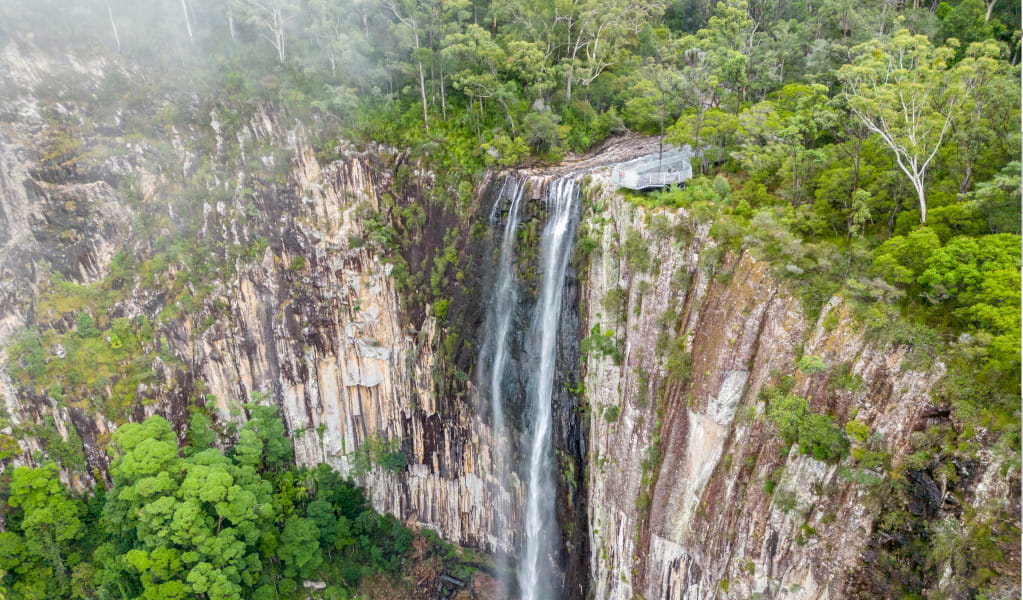Nightcap National Park
Overview
Explore ancient World Heritage-listed rainforest in Nightcap National Park, near Lismore in north-eastern NSW. You’ll find picnic areas and stunning views from Minyon Falls lookout. Camp in nearby Rummery Park campground.
Read more about Nightcap National Park
Nightcap National Park, part of the Gondwana Rainforests of Australia World Heritage Area, is a dramatically beautiful park full of ancient rainforests, magical waterways and spectacular views.
The lush rainforest provides a home for the newly discovered nightcap oak as well as a number of threatened animal species, including Albert's lyrebird and Fleay's barred frog which takes shelter under leaf litter and makes an 'ok-ok-ok-ok-ok' after rain.
With easy access from Lismore and Nimbin, you can enjoy a picnic, bushwalk or overnight camping trip amid the park's escarpments, waterfalls and crystal clear creeks and enjoy incredible views of the 20 million year-old Wollumbin shield volcano. Learn more about the special origin of this park and the protests to protect Terania Creek.
Local alerts
For the latest updates on fires, closures and other alerts in this area, see https://www.nationalparks.nsw.gov.au/visit-a-park/parks/nightcap-national-park/local-alerts
Map
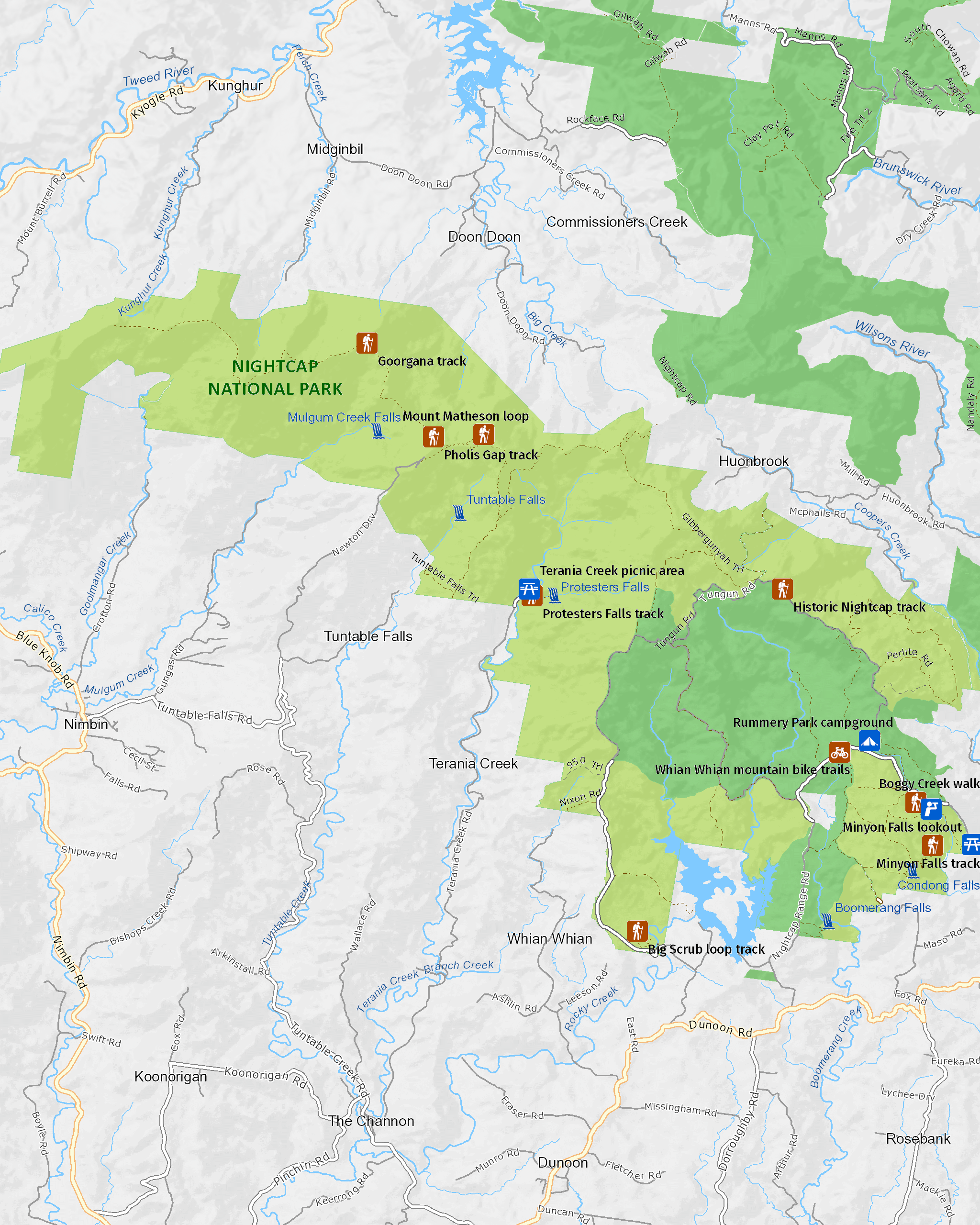
Map legend

Contact
- in the North Coast region
Nightcap National Park is always open but may have to close at times due to poor weather, fire danger or management operations.
-
-
Alstonville office
02 6627 0200
Contact hours: Monday to Friday, 8:30am to 4:30pm - Russelton Industrial Estate, 7 Northcott Crescent, Alstonville NSW 2477
-
Email: npws.richmondriver@environment.nsw.gov.au
-
Alstonville office
Visitor info
All the practical information you need to know about Nightcap National Park.
Getting there and parking
Get driving directions
From Lismore:
- Drive 35km to the northern rivers area of NSW
- Road access is from one of five roads from the Richmond Valley in the south, four of which are unsealed
Parking
- Minyon Falls lookout See on map
- Minyon Grass picnic area See on map
- Terania Creek picnic area See on map
By bike
Check out the Bicycle information for NSW website for more information.
Best times to visit
There are lots of great things waiting for you in Nightcap National Park. Here are some of the highlights: Weather in the northern rivers region is generally mild in winter ranging to hot in summer. It can be very wet (the park receives the highest annual rainfall in NSW) and misty so check local weather conditions and pack suitable clothes as well as a hat, sunscreen and insect repellent.
Weather, temperature and rainfall
Summer temperature
Average
18°C and 29°C
Highest recorded
40°C
Winter temperature
Average
6°C and 19°C
Lowest recorded
-0.6°C
Rainfall
Wettest month
February
Driest month
September
The area’s highest recorded rainfall in one day
350mm
Facilities
Amenities
Toilets
Picnic tables
Drinking water
Maps and downloads
Prohibited
Pets
Pets and domestic animals (other than certified assistance animals) are not permitted. Find out which regional parks allow dog walking and see the pets in parks policy for more information.
Smoking
NSW national parks are no smoking areas.
Nearby towns
Nimbin (11 km)
Nimbin is the counter-culture capital of Australia. It's set in a beautiful green valley pierced with limestone spires.
Lismore (27 km)
Lismore is a major North Coast commercial, cultural and administrative centre. It's set in undulating country on the north arm of the Richmond River.
Mullumbimby (32 km)
Mullumbimby sits on the Brunswick River and is overshadowed by subtropical hills.
Learn more
Nightcap National Park is a special place. Here are just some of the reasons why:
Ancient rainforest
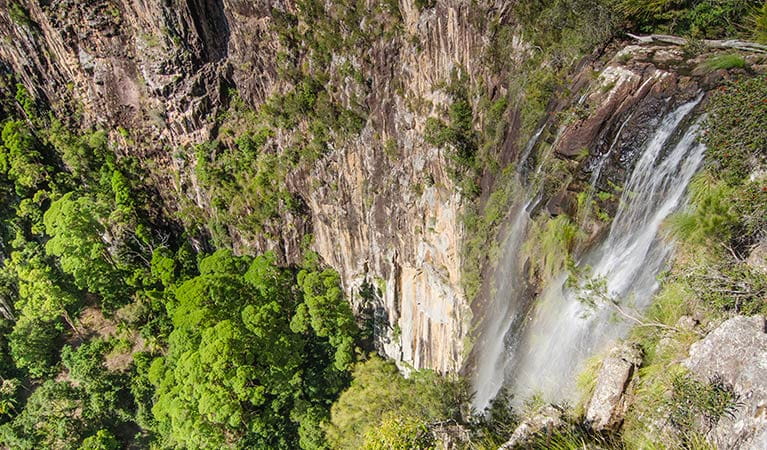
Nightcap National Park's rainforests are part of the Gondwana Rainforests of Australia World Heritage Area, the largest area of subtropical rainforest in the world. They are a living link to the environment of ancient Australia and give us insight into the environment of the ancient supercontinent of Gondwana.
This lush and diverse conservation area protects a number of vulnerable and threatened species such as the rufous scrub bird, red goshawk, sooty and masked owls and regent bowerbirds. It is also home to the recently discovered nightcap oak, which can grow up to 40m high.
Ground-breaking protests at Terania Creek in the late 1970's paved the way for the park's creation and international recognition as a Gondwana Rainforest World Heritage site in 1986.
- Minyon Falls guided rainforest tour Journey through ancient rainforest to Minyon Falls on a 5-hour tour with Wild Byron. You’ll see the stunning creeks, waterfalls and wildlife of Nightcap National Park.
- Minyon Falls walking tours Join Earthbound Tours for a guided walk to Minyon Falls, located in Nightcap National Park, near Byron Bay. You'll walk through ancient rainforest for an up-close look at these spectacular falls.
- Protesters Falls walking track Protesters Falls walking track leads through superb World Heritage rainforest before arriving at spectacular waterfalls in Nightcap National Park, near Lismore.
- Terania Creek picnic area Terania Creek picnic area is a great place for a family picnic or barbecue. Close to the carpark, walking tracks and waterfalls, its home to birds and goannas.
History buffs
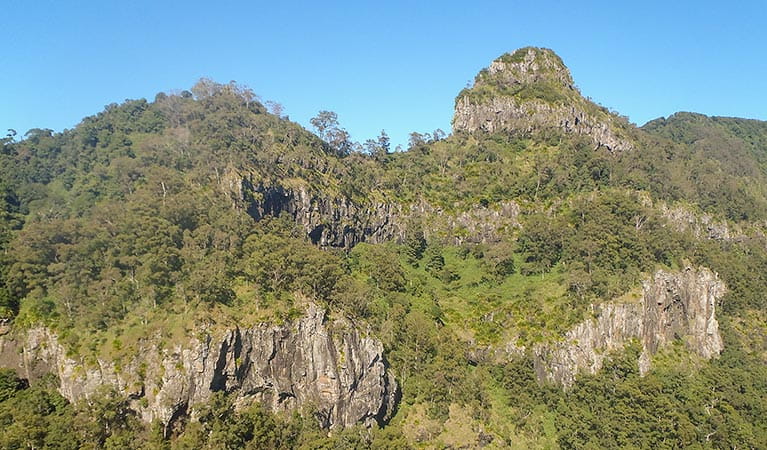
Nightcap National Park contains a number of sites of historical interest, including a flying fox on the Googarna track. The flying fox was used to lower logs 500m down to the Kunghur mill during the 1940s and 1950s. The historic Nightcap track provided the first bridle track and telegraph line between the Richmond and Tweed valleys in the 1870s, and today you can explore this track on foot, camping overnight in the bush.
Aboriginal heritage
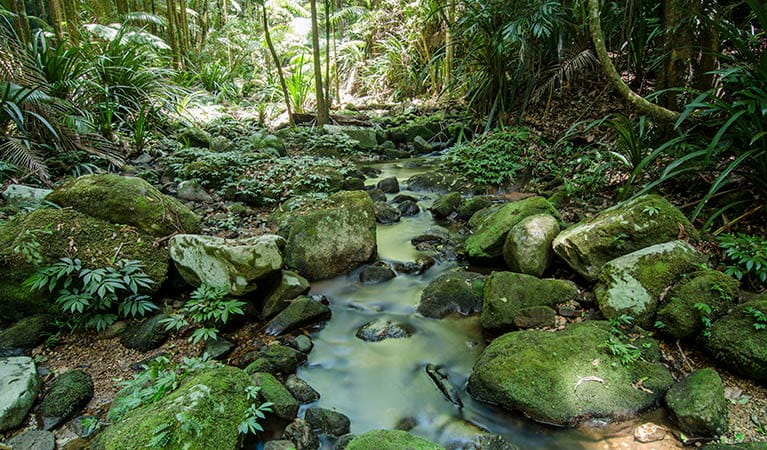
Nightcap National Park is the traditional land of the Bundjalung People, in particular the Widjabul People who have inhabited the area for thousands of years. The park contains many ancient sites of cultural significance, including ceremonial and sacred sites that are still used by local Aboriginal people today. The creeks, plants, animals and landscape of the park feature in the stories, teachings and practices of Aboriginal people that continue to be passed on today.
Frogs galore
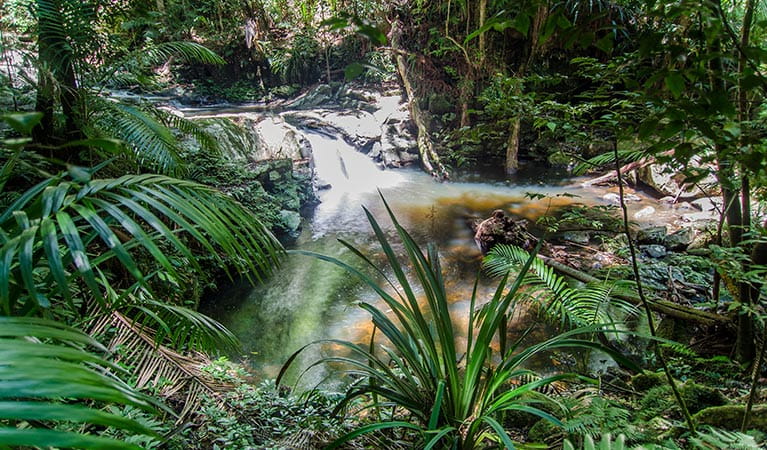
The rainforest creeks in Nightcap National Park are home to a number of threatened frogs, including Fleay's barred frog and the pouched frog. You might see Fleay's barred frogs hiding under leaf litter near streams or foraging for food on the rainforest floor, but you're more likely to hear their chorus, a distinctive 'arrrrrrk'. This rare frog feeds mainly on insects and invertebrates, so crickets, moths and beetles make a good meal. Keep your eyes open for this pale brown frog around Terania creek at the base of Protesters Falls.
- Byron glow worms and hinterland forest experience Discover Byron Bay’s spiritual side and see glow worms and enchanting forest sights on this guided outing with Rise Up – Byron Conscious Tours. You'll delight your senses and relax your mind as you explore the wilderness in and around Nightcap National Park.
- Goorgana walking track Goorgana walking track is ideal for experienced bushwalkers keen to tackle the challenging iconic peaks in Nightcap National Park.
- Minyon Falls guided rainforest tour Journey through ancient rainforest to Minyon Falls on a 5-hour tour with Wild Byron. You’ll see the stunning creeks, waterfalls and wildlife of Nightcap National Park.
- Night vision rainforest walks in Byron Bay Discover elusive native animals at night as you strap on a pair of special goggles and venture out for a thrilling rainforest tour beneath the stars with the friendly guides of Vision Walks Eco Tours.
- Terania Creek picnic area Terania Creek picnic area is a great place for a family picnic or barbecue. Close to the carpark, walking tracks and waterfalls, its home to birds and goannas.
Plants and animals protected in this park
Animals
-
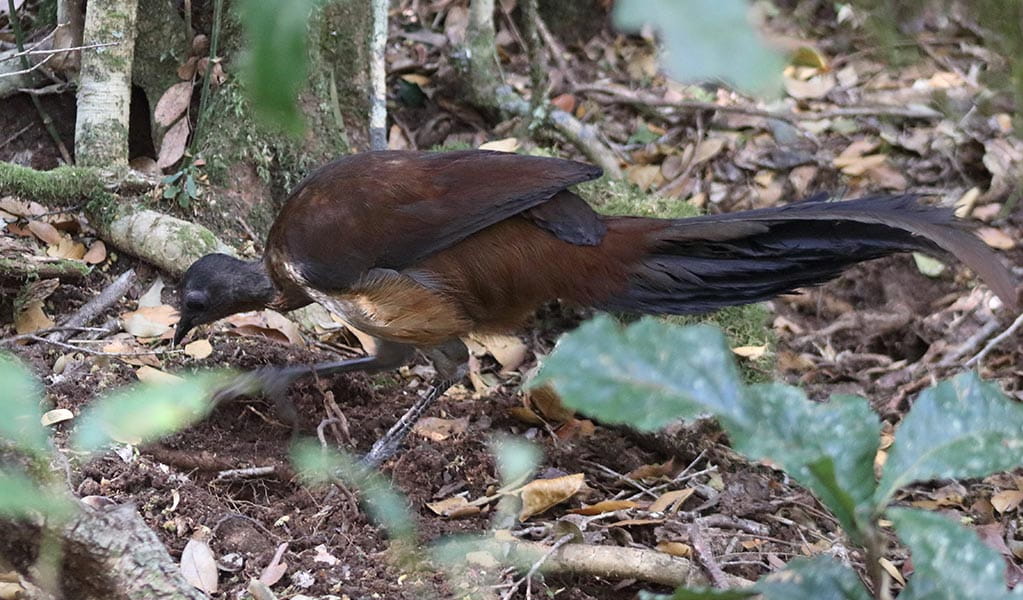
Albert's lyrebird (Menura alberti)
The Albert’s lyrebird is much rarer than the superb lyrebird. Distinguished by its richer brown plumage and less elaborate tail feathers, it’s protected as a threatened species in NSW.
-
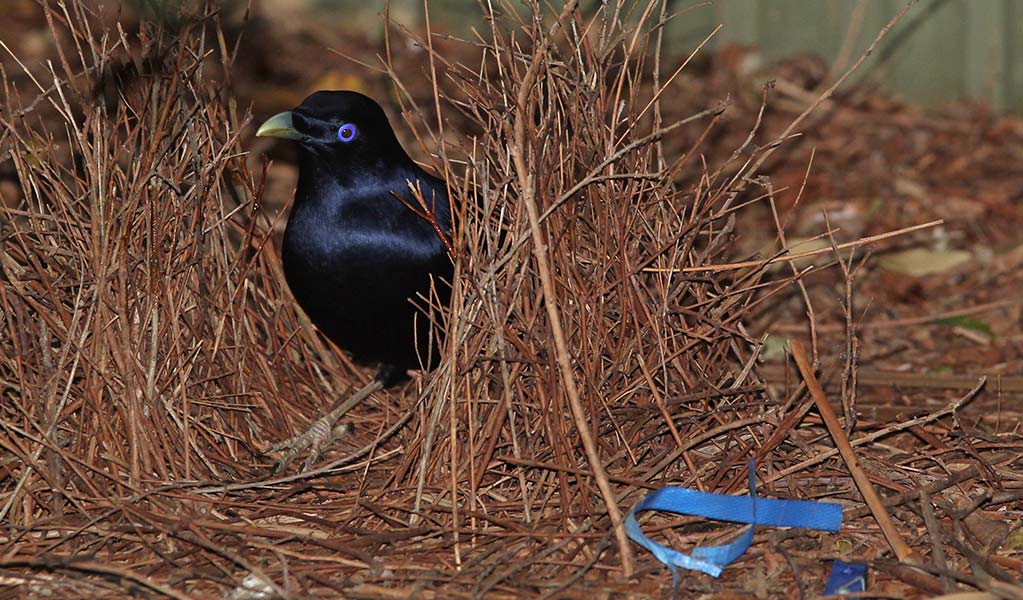
Satin bowerbird (Ptilonorhynchus violaceus)
With vibrant blue-violet eyes and curious antics, the satin bowerbird is a favourite for bird watching and easy to spot as it forages for food in open forest. Relatively common across eastern Australia, in NSW they’re found in coastal rainforests and adjacent woodlands and mountain ranges.
-
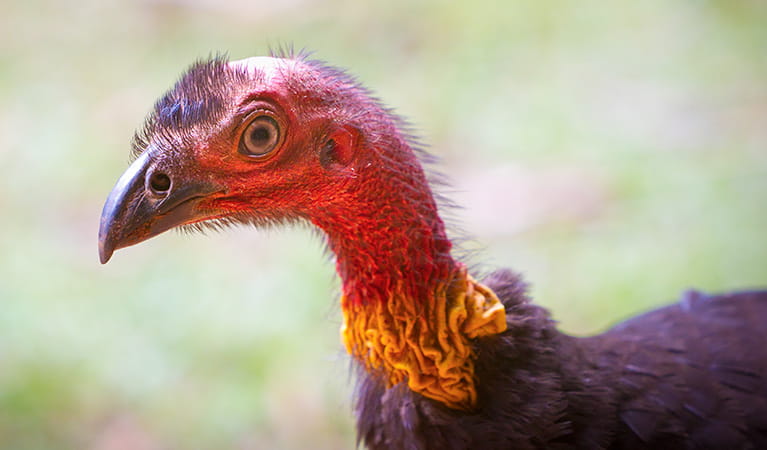
Australian brush turkey (Alectura lathami)
The Australian brush turkey, also known as bush or scrub turkey, can be found in rainforests along eastern NSW. With a striking red head, blue-black plumage and booming call, these distinctive Australian birds are easy to spot while bird watching in several NSW national parks.
-
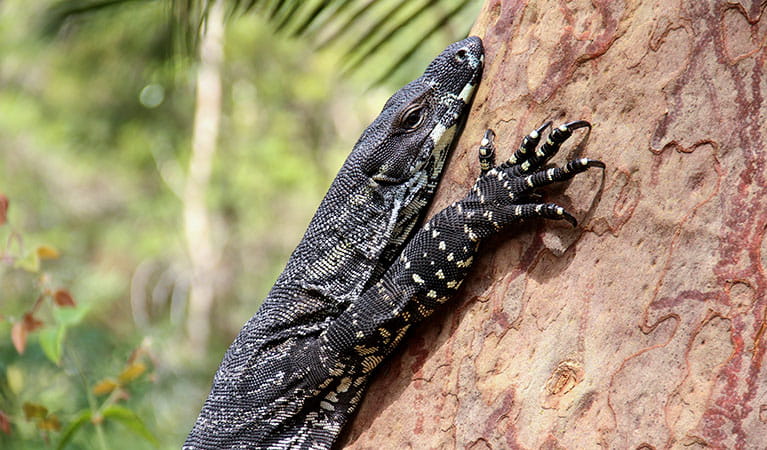
Lace monitor (Varanus varius)
One of Australia’s largest lizards, the carnivorous tree-dwelling lace monitor, or tree goanna, can grow to 2m in length and is found in forests and coastal tablelands across eastern Australia. These Australian animals are typically dark blue in colour with whitish spots or blotches.
-
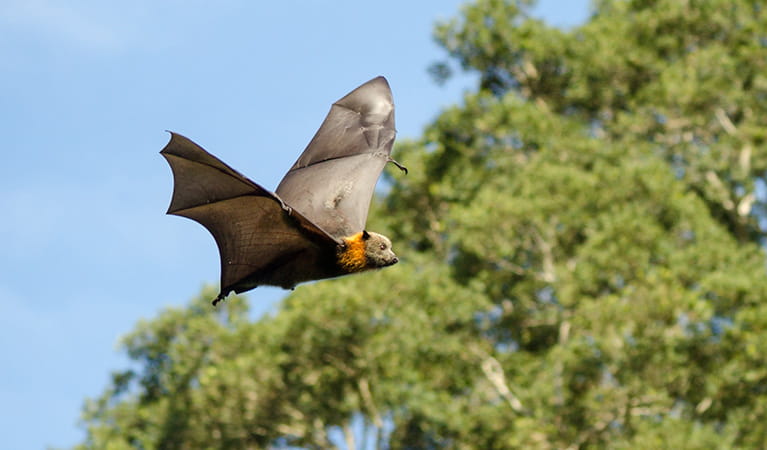
Grey-headed flying-fox (Pteropus poliocephalus)
The grey-headed flying fox is Australia's largest native bat, with a wingspan up to 1m. This threatened species travels up and down south-eastern Australia and plays a vital role in pollinating plants and spreading seeds in our native forests.
Plants
-
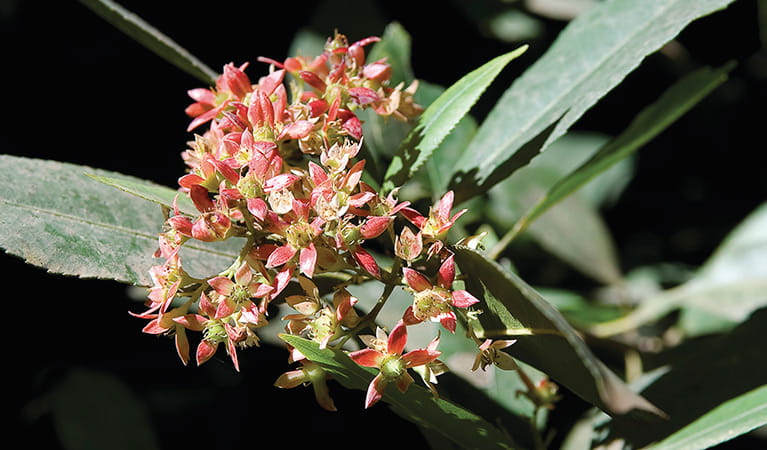
Coachwood (Ceratopetalum apetalum)
Coachwood trees are Australian native plants that grow in warm temperate rainforests along coastal NSW. Also known as scented satinwood, the mottled grey bark of the coachwood has horizontal markings and a delicate fragrance.
-
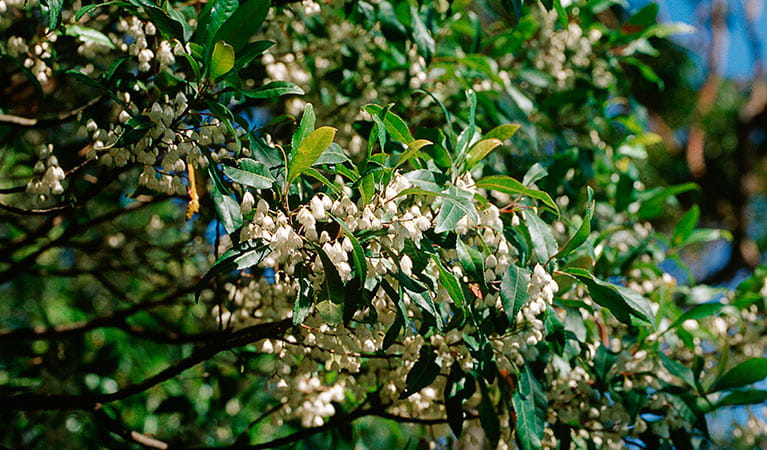
Blueberry ash (Elaeocarpus reticulatus)
The blueberry ash is a rainforest shrub which produces blue olive-shaped berries and spectacular bell-shaped flowers, which often appear on the plant together. It is a tall slender shrub or small tree found in rainforest, tall eucalypt forest and coastal bushland in eastern NSW, south-east Queensland and Victoria.
Environments in this park
Education resources (1)
What we're doing
Nightcap National Park has management strategies in place to protect and conserve the values of this park. Visit the OEH website for detailed park and fire management documents. Here is just some of the work we’re doing to conserve these values:
Preserving biodiversity
Nightcap National Park observes and supports the plant and animal species within its borders. Efforts to minimise the impacts of threats are ongoing within this park and include frequent monitoring and pest management. NPWS is committed to plant and animal conservation, and protects threatened, vulnerable and endangered species within all NSW national parks.
Managing weeds, pest animals and other threats
Pests and weeds have a significant impact to the ecosystems within Nightcap National Park. NPWS carries out risk assesments for new and emerging weeds as well as cane toad and wild dog control to protect biodiversity in this park.
Developing visitor facilities and experiences
NPWS is committed to providing numerous high-quality facilities for visitors to enjoy in all its parks. Park visitors are well catered for, and the park’s recreational facilities are frequently reviewed, with opportunities examined for future amendments.
Managing fire
NSW is one of the most bushfire prone areas in the world as a result of our climate, weather systems, vegetation and the rugged terrain. NPWS is committed to maintaining natural and cultural heritage values and minimising the likelihood and impact of bushfires via a strategic program of fire research, fire planning, hazard reduction, highly trained rapid response firefighting crews and community alerts.

